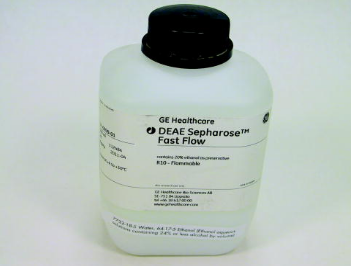DEAE Sepharose Fast Flow, 500 mL
DEAE Sepharose Fast Flow is a weak anion exchanger based on the well established Sepharose Fast Flow ion exchange platform, extensively used for preparative protein separations in both research and industrial applications.
Well-proven weak anion exchanger developed for industrial downstream processes
Used extensively for capture and intermediate purification of a wide range of approved biopharmaceuticals
The industry standard for ion exchange chromatography during recent decades
High chemical stability allows for well proven CIP and sanitization protocols
The hydrophilic nature of the base matrix ensures low levels of non-specific binding leading to low levels of host cell-derived impurities in the elution pool.
DEAE Sepharose Fast Flow is part of the Sepharose Fast Flow ion exchange platform, which has been the industrial standard for ion exchange chromatography during recent decades. It is composed of cross-linked, 6% agarose particles, with diethylaminoethyl (DEAE) weak anion exchange groups. DEAE Sepharose Fast Flow has high chemical stability, allowing well proven cleaning-in-place (CIP) and sanitization protocols. Scale-up with DEAE Sepharose Fast Flow is straight forward and the resin is available in a range of pre-packed process development tools.
As member of the BioProcess resins range, DEAE Sepharose Fast Flow meets industrial demands with security of supply and comprehensive technical and regulatory support.
DEAE Sepharose Fast Flow, 500 mL
| BioProcess resin | Yes |
| Ligand | Diethylaminoethyl |
| Particle size, d50V | ~90 µm1) |
| Ion Exchanger Type | Weak anion exchanger |
| Matrix | cross-linked agarose, 6%, spherical |
| Ionic Capacity | 0.11–0.16 mmol (Cl-)/mL resin |
| pH stability, operational | 2–122) |
| pH stability, CIP | 2–143) |
| pH ligand fully charged | Below 94) |
| Pressure/Flow Specification | 300-600 cm/h, 100 kPa, XK 50/30 column, bed height 15 cm |
| Exclusion Limit [Mr] [Globular Proteins] | ~4 × 106 |
| Storage | 4 to 30°C, 20% Ethanol |
| Chemical Stability | Stable to commonly used aqueous buffers:1.0 M NaOH, 8 M urea, 8 M guanidine hydrochloride, 70% ethanol5) |
| Certificate of Analysis | Yes |
| 1)Median particle size of the cumulative volume distribution |
| 2)pH range where resin can be operated without significant change in function. |
| 3)pH range where resin can be subjected to cleaning- or sanitization-in-place without significant change in function. |
| 4)pH range where ligand is fully charged. |
| 5)1 M NaOH and acetic acid should be used only for cleaning purposes. |

 010-64814275
010-64814275
 當前位置:
當前位置:



 010-64814275
010-64814275
 010-64814275
010-64814275
 2850669802
2850669802